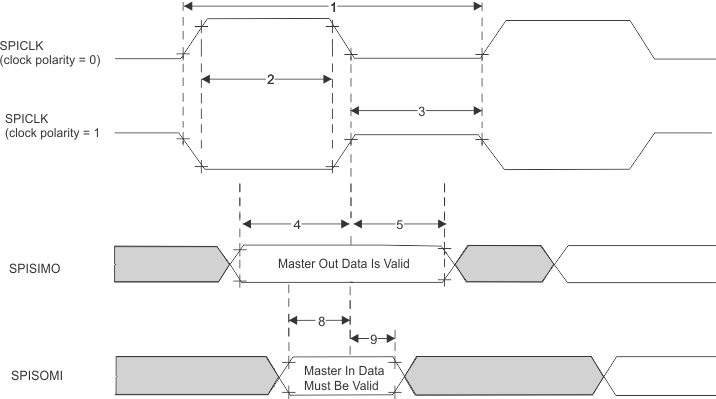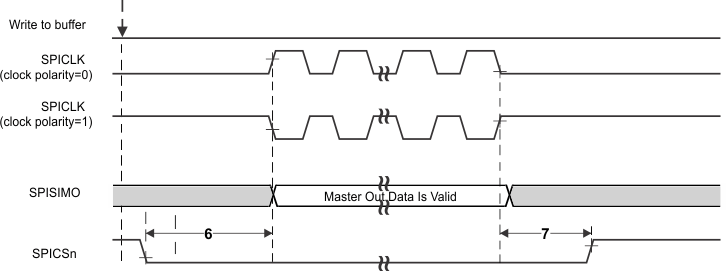ZHCSHP9C May 2017 – October 2018 IWR1443
PRODUCTION DATA.
- 1器件概述
- 2修订历史记录
- 3Device Comparison
- 4Terminal Configuration and Functions
-
5Specifications
- 5.1 Absolute Maximum Ratings
- 5.2 ESD Ratings
- 5.3 Power-On Hours (POH)
- 5.4 Recommended Operating Conditions
- 5.5 Power Supply Specifications
- 5.6 Power Consumption Summary
- 5.7 RF Specification
- 5.8 Thermal Resistance Characteristics for FCBGA Package [ABL0161]
- 5.9
Timing and Switching Characteristics
- 5.9.1 Power Supply Sequencing and Reset Timing
- 5.9.2 Synchronized Frame Triggering
- 5.9.3 Input Clocks and Oscillators
- 5.9.4 Multibuffered / Standard Serial Peripheral Interface (MibSPI)
- 5.9.5 LVDS Interface Configuration
- 5.9.6 General-Purpose Input/Output
- 5.9.7 Controller Area Network Interface (DCAN)
- 5.9.8 Serial Communication Interface (SCI)
- 5.9.9 Inter-Integrated Circuit Interface (I2C)
- 5.9.10 Quad Serial Peripheral Interface (QSPI)
- 5.9.11 JTAG Interface
- 5.9.12 Camera Serial Interface (CSI)
- 6Detailed Description
- 7Applications, Implementation, and Layout
- 8Device and Documentation Support
- 9Mechanical, Packaging, and Orderable Information
Table 5-9 SPI Master Mode Switching Parameters (CLOCK PHASE = 0, SPICLK = output,
SPISIMO = output, and SPISOMI = input)(1)(2)(3)
| NO. | PARAMETER | MIN | TYP | MAX | UNIT | ||
|---|---|---|---|---|---|---|---|
| 1 | tc(SPC)M | Cycle time, SPICLK(4) | 25 | 256tc(VCLK) | ns | ||
| 2(4) | tw(SPCH)M | Pulse duration, SPICLK high (clock polarity = 0) | 0.5tc(SPC)M – 4 | 0.5tc(SPC)M + 4 | ns | ||
| tw(SPCL)M | Pulse duration, SPICLK low (clock polarity = 1) | 0.5tc(SPC)M – 4 | 0.5tc(SPC)M + 4 | ||||
| 3(4) | tw(SPCL)M | Pulse duration, SPICLK low (clock polarity = 0) | 0.5tc(SPC)M – 4 | 0.5tc(SPC)M + 4 | ns | ||
| tw(SPCH)M | Pulse duration, SPICLK high (clock polarity = 1) | 0.5tc(SPC)M – 4 | 0.5tc(SPC)M + 4 | ||||
| 4(4) | td(SPCH-SIMO)M | Delay time, SPISIMO valid before SPICLK low, (clock polarity = 0) | 0.5tc(SPC)M – 3 | ns | |||
| td(SPCL-SIMO)M | Delay time, SPISIMO valid before SPICLK high, (clock polarity = 1) | 0.5tc(SPC)M – 3 | |||||
| 5(4) | tv(SPCL-SIMO)M | Valid time, SPISIMO data valid after SPICLK low, (clock polarity = 0) | 0.5tc(SPC)M – 10.5 | ns | |||
| tv(SPCH-SIMO)M | Valid time, SPISIMO data valid after SPICLK high, (clock polarity = 1) | 0.5tc(SPC)M – 10.5 | |||||
| 6(5) | tC2TDELAY | Setup time CS active until SPICLK high
(clock polarity = 0) |
CSHOLD = 0 | (C2TDELAY+2)*tc(VCLK) – 7.5 | (C2TDELAY+2) * tc(VCLK) + 7 | ns | |
| CSHOLD = 1 | (C2TDELAY +3) * tc(VCLK) – 7.5 | (C2TDELAY+3) * tc(VCLK) + 7 | |||||
| Setup time CS active until SPICLK low
(clock polarity = 1) |
CSHOLD = 0 | (C2TDELAY+2)*tc(VCLK) – 7.5 | (C2TDELAY+2) * tc(VCLK) + 7 | ||||
| CSHOLD = 1 | (C2TDELAY +3) * tc(VCLK) – 7.5 | (C2TDELAY+3) * tc(VCLK) + 7 | |||||
| 7(5) | tT2CDELAY | Hold time, SPICLK low until CS inactive (clock polarity = 0) | 0.5*tc(SPC)M + (T2CDELAY + 1) *tc(VCLK) – 7 | 0.5*tc(SPC)M + (T2CDELAY + 1) * tc(VCLK) + 7.5 | ns | ||
| Hold time, SPICLK high until CS inactive (clock polarity = 1) | 0.5*tc(SPC)M + (T2CDELAY + 1) *tc(VCLK) – 7 | 0.5*tc(SPC)M + (T2CDELAY + 1) * tc(VCLK) + 7.5 | |||||
| 8(4) | tsu(SOMI-SPCL)M | Setup time, SPISOMI before SPICLK low
(clock polarity = 0) |
5 | ns | |||
| tsu(SOMI-SPCH)M | Setup time, SPISOMI before SPICLK high
(clock polarity = 1) |
5 | |||||
| 9(4) | th(SPCL-SOMI)M | Hold time, SPISOMI data valid after SPICLK low
(clock polarity = 0) |
3 | ns | |||
| th(SPCH-SOMI)M | Hold time, SPISOMI data valid after SPICLK high
(clock polarity = 1) |
3 | |||||
(1) The MASTER bit (SPIGCRx.0) is set and the CLOCK PHASE bit (SPIFMTx.16) is cleared (where x= 0 or 1).
(2) tc(MSS_VCLK) = master subsystem clock time = 1 / f(MSS_VCLK). For more details, see the Technical Reference Manual.
(3) When the SPI is in Master mode, the following must be true: For PS values from 1 to 255: tc(SPC)M ≥ (PS +1)tc(MSS_VCLK) ≥ 25ns, where PS is the prescale value set in the SPIFMTx.[15:8] register bits. For PS values of 0: tc(SPC)M = 2tc(MSS_VCLK) ≥ 25ns.
(4) The active edge of the SPICLK signal referenced is controlled by the CLOCK POLARITY bit (SPIFMTx.17).
(5) C2TDELAY and T2CDELAY is programmed in the SPIDELAY register
 Figure 5-5 SPI Master Mode External Timing (CLOCK PHASE = 0)
Figure 5-5 SPI Master Mode External Timing (CLOCK PHASE = 0)  Figure 5-6 SPI Master Mode Chip Select Timing (CLOCK PHASE = 0)
Figure 5-6 SPI Master Mode Chip Select Timing (CLOCK PHASE = 0)